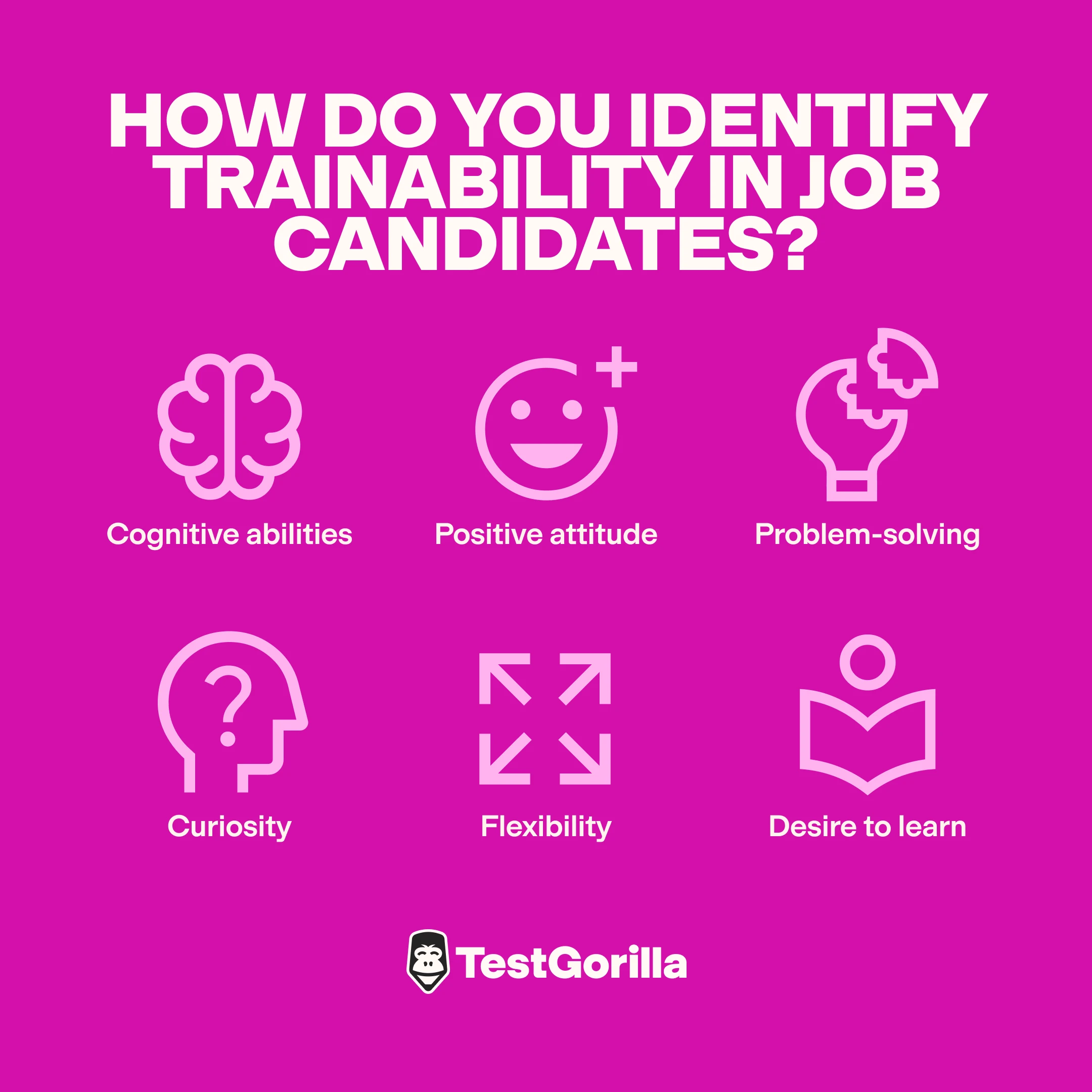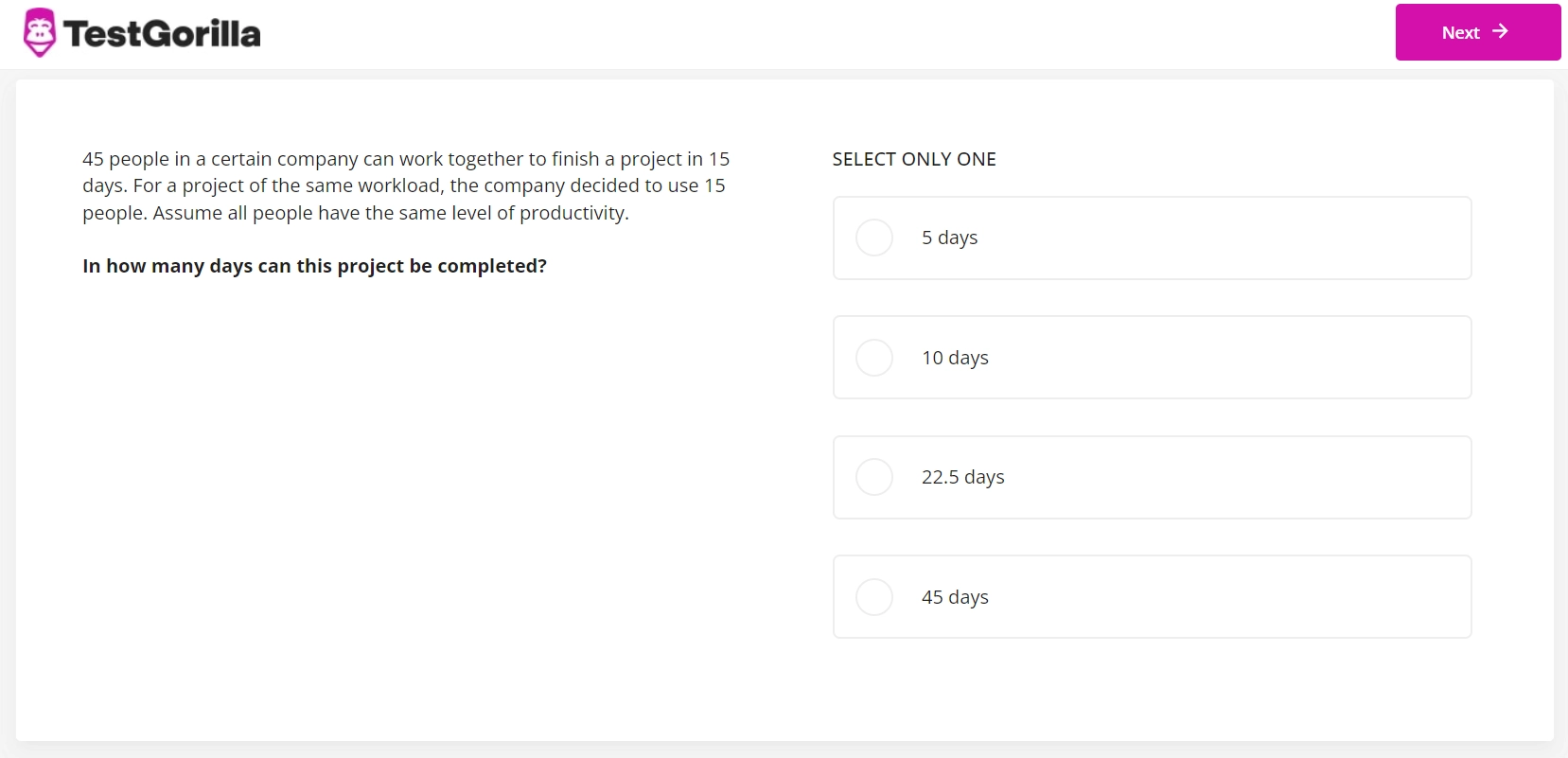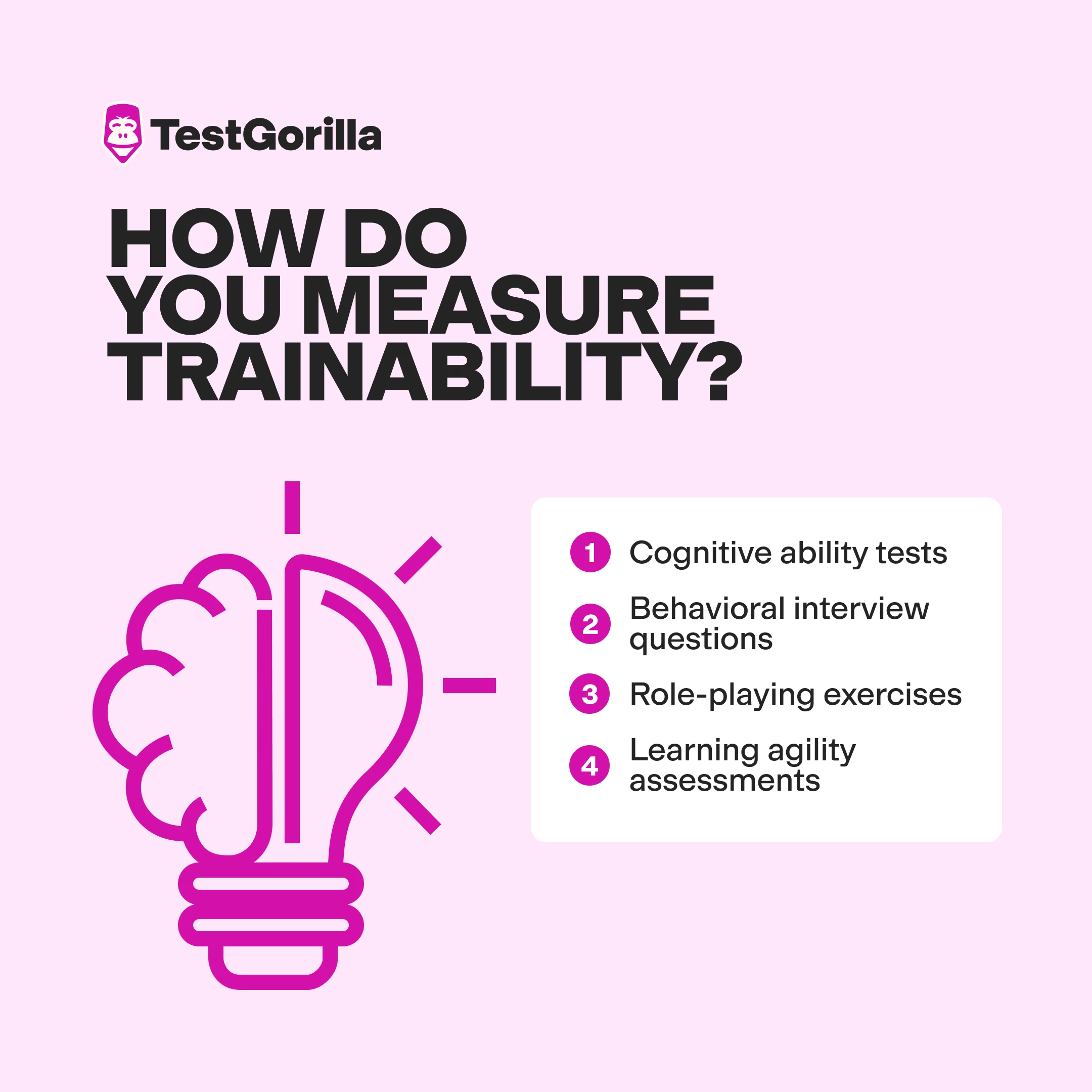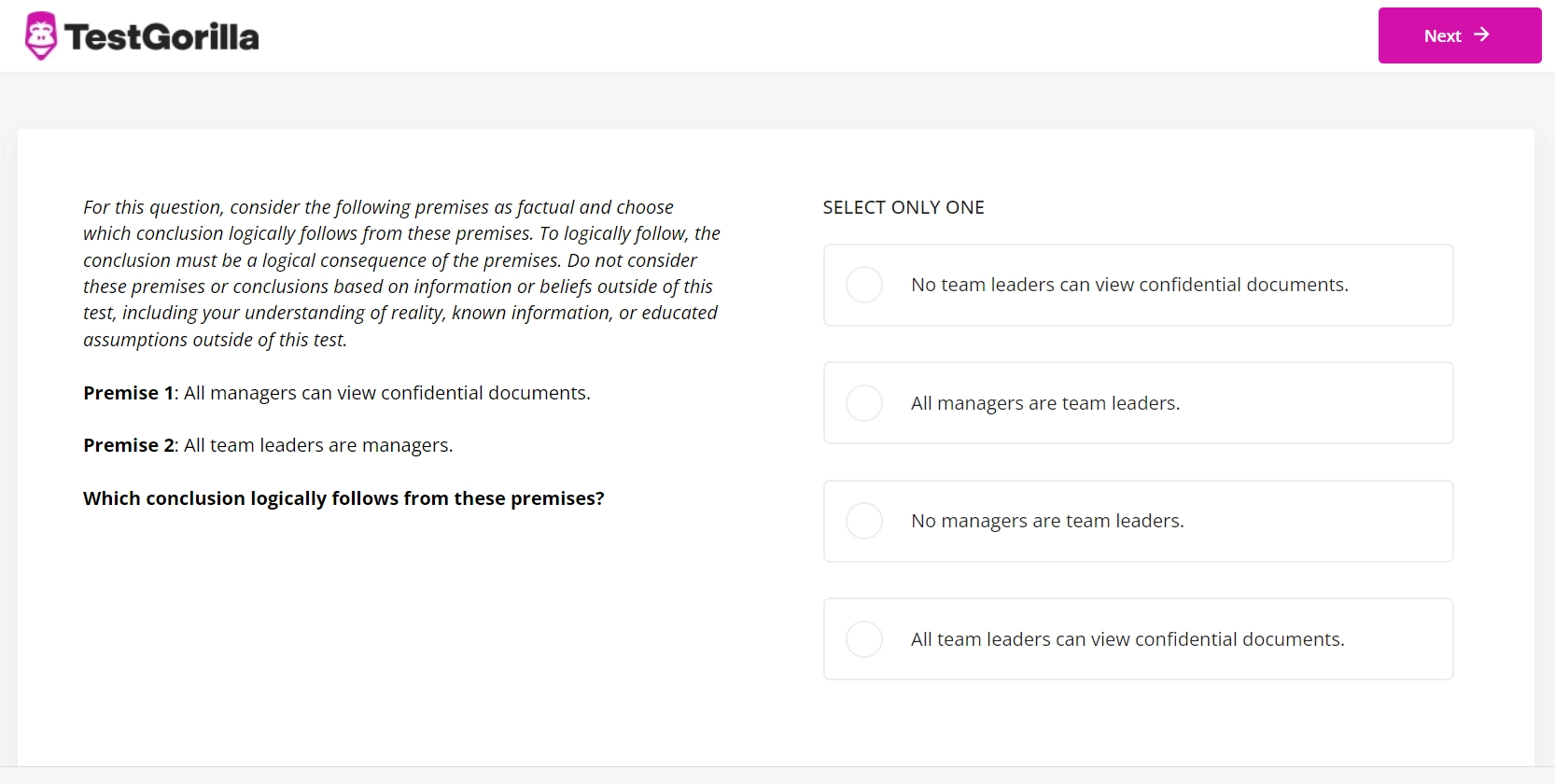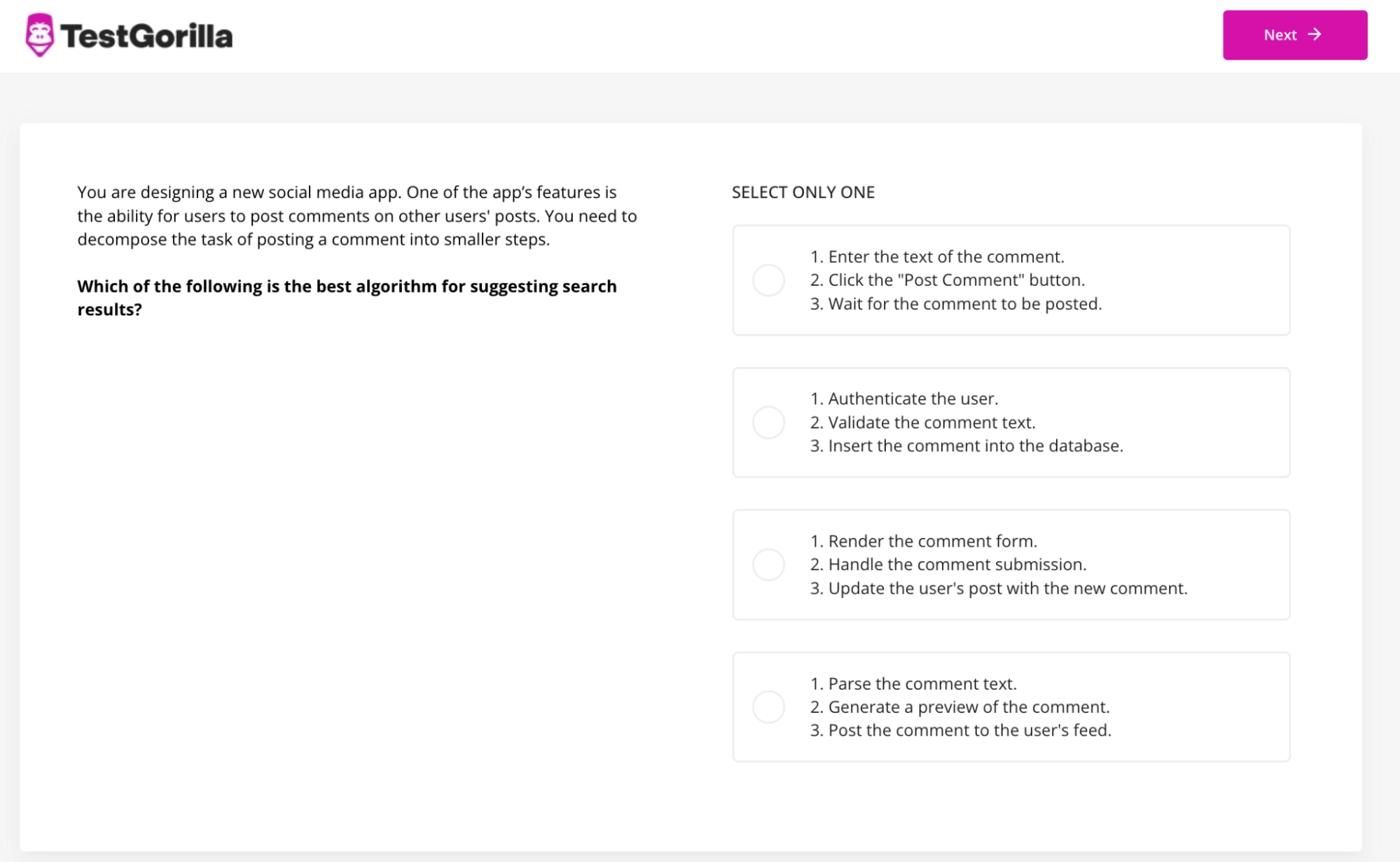Trainability: Why it matters and how to look for it in candidates
Looking to assess trainability in your candidates?
Today, organizations need employees who can quickly adapt to new tools and processes, learn and refine their skills, and stay up to date with the latest industry trends.
However, it is difficult to identify genuinely trainable candidates in a sea of polished resumes and rehearsed interviews, which can lead to costly hiring mistakes.
This makes it critical to find a method for identifying candidates with trainability traits, such as problem-solving, cognitive flexibility, and a desire to learn – which are all directly linked to a person’s cognitive abilities.
In this article, we discuss trainability, why it’s important, and how to use a skills-based approach to identify it in your candidates.
What is trainability?
Trainability refers to someone’s ability to learn new things quickly and efficiently. It’s a crucial trait that indicates how receptive an individual is to being taught and trained in new roles or systems. Trainability is essential for absorbing new information, adapting to challenges, and acquiring new skills, which are vital in modern workplaces.
Highly trainable employees often possess certain baseline cognitive abilities, such as flexibility and variability.
Cognitive flexibility is the ability to switch between concepts or modify behavior to help you achieve goals in a changing environment. It shows that you can stay flexible about how you learn new things. People with greater cognitive flexibility enjoy several benefits, such as higher stress resilience and enhanced creativity.
Use TestGorilla to measure cognitive flexibility
Our assessments enable you to spot flexible candidates with the right skills for the role. Simply select the right evaluations and get a 360-degree view of your candidates.
Why is trainability important?
Trainability is important because employees who are willing and able to learn new skills can quickly adapt to changing job requirements, making them valuable assets to their organizations.
Here are a few ways in which an advanced search for trainable employees can benefit your organization:
Adaptability to change: Trainable employees can adapt more quickly to new technologies, processes, or shifts in business strategy, which is vital for productivity and efficiency.
Cost-effectiveness: According to the Society for Human Resource Management, the average cost per hire is almost $4,700. Training existing employees is often less expensive than hiring new ones.
Increased employee motivation: Employees eager to learn and grow are more likely to take advantage of opportunities for advancement because they are willing to take on new challenges and responsibilities.
Better business outcomes: Employers who invest in their employees’ learning and development build a workforce with the skills they need to succeed in the long term.
Innovation potential: A highly trainable employee is more open to learning and trying new approaches, which is vital for innovation. According to 84% of executives, innovation is crucial for their company’s growth planning.
Reduced employee turnover: Employees who adapt and grow with the company are more likely to be satisfied with their jobs and stay longer, which reduces employee turnover rates.
Considering that more than 60% of recruiting teams struggle to find new hires with the right skills, it’s important to at least identify people you can train easily. Focusing on talent or trainability can help new hires quickly adapt and grow within your organization.
Organizations can use various training methods tailored to their operational needs and employee preferences to cultivate a culture of trainability. These include:
Continuous learning and skills development
A technical skills training program
Professional learning opportunities like conferences and workshops
The best insights on HR and recruitment, delivered to your inbox.
Biweekly updates. No spam. Unsubscribe any time.
How to identify trainability in candidates: 6 traits and skills
What do you do when two or more candidates have the same experience on paper and similar skills test results?
The solution is to identify which candidate possesses more trainability traits.
Look for these six traits to uncover the most suitable applicants during your hiring process:
1. Cognitive abilities
Candidates with strong cognitive skills can analyze information and adapt to their surroundings. They are quick learners and can identify patterns and trends, making learning new skills easier.
When assessing a candidate’s cognitive abilities, consider their brainpower and ability to think creatively and make decisions based on logical reasoning.
2. Positive attitude
Candidates who are enthusiastic and optimistic about learning new things are more likely to take the initiative, seek out challenges, and embrace new ideas. They are typically more resilient and adaptable to changes in their work environment and are less likely to become discouraged by setbacks or obstacles.
Conversely, people with a negative attitude are often more difficult to train and less motivated to do something outside their comfort zone.
When assessing a candidate’s attitude, measure their job motivation, willingness to take risks, and genuine interest in the position and the company.
3. Problem-solving
Employees who are skilled problem-solvers are more likely to be adaptable and learn new skills quickly.
They can identify issues, evaluate potential solutions, and take the necessary steps to implement them. Problem-solvers are skilled at creating and adjusting their schedules and prioritizing tasks based on importance.
When assessing a candidate’s problem-solving skills, consider their ability to analyze complex issues, develop solutions, and implement them effectively. You can do that with our Problem Solving test.
Check out the Problem Solving test preview for more questions from this test.
4. Curiosity
Naturally curious candidates tend to be more open-minded and likely to seek new information and learning opportunities. They are more passionate about their position and aim to achieve the best results.
When assessing an applicant’s curiosity, evaluate their knowledge of your company and its products or services and how open they are to exploring new ideas or ways of working.
5. Flexibility
Job candidates who can adapt to unfamiliar situations and work effectively in different environments are more likely to succeed in roles that require frequent change or a variety of tasks.
When assessing a candidate’s flexibility, consider their ability to remain productive in changing circumstances, willingness to take on new responsibilities, and capacity to adapt to new technologies or processes. These are predictors of trainability.
It’s also important to assess how potential employees approach feedback and their readiness to apply it.
6. Desire to learn
Finally, candidates with a strong desire to learn are more likely to succeed in roles that require continuous improvement and skill development.
They are motivated to take on new challenges and are committed to growing their skills and knowledge.
When assessing a candidate’s desire to learn, look for self-motivation and dedication to ongoing professional development, including enthusiasm for taking courses, participating in workshops, and staying updated with industry trends.
Discover trainable talent with TestGorilla
Using our skills tests helps you identify candidates with the right mix of personality traits, cognitive abilities, and specific skills.
How to evaluate trainability in top talent
Measuring trainability is a complex process that involves assessing a candidate’s potential to learn and adapt to unfamiliar situations.
The value of skills decreases by half every four years, so it’s important to have employees who are able and willing to train and learn new skills continuously.
Below, we share some common methods to measure someone’s trainability.
1. Cognitive ability tests
Cognitive ability tests help assess a candidate’s ability to learn and solve problems.
These tests typically include math, reading comprehension, and logical reasoning tasks. Language tests (such as English or Mandarin Chinese) are also a good idea if you’re hiring remotely or planning an international expansion. These assessments provide insight into a candidate’s potential for success in roles that require advanced cognitive skills.
For example, you can use our Critical Thinking test to identify potential employees who are good at evaluating information and making sound decisions using analytical skills.
2. Behavioral interview questions
Asking candidates behavioral interview questions can help identify their past behaviors and ability to learn from their experiences.
For example, you can ask applicants to describe an experience from their personal life when they had to overcome an obstacle. Their answers can provide insight into their problem-solving skills and ability to adapt to new situations.
When conducting interviews, ask as many questions as possible to determine how your candidates think and act in certain situations. Consider using these behavioral questions as an intro to (or in combination with) our next method: role-playing exercises.
3. Role-playing exercises
These simple exercises can help you find out more about a candidate’s ability to adapt to new situations and think on their feet.
For example, presenting a hypothetical business scenario (related to the role at hand) and asking candidates to devise a solution can provide insight into their problem-solving skills and ability to handle unfamiliar situations.
In addition, you can use role-playing scenarios to create job simulations and get a real sense of how that candidate performs on the job.
4. Learning agility assessments
Learning agility assessments measure a candidate’s ability to learn from new experiences and adapt their behavior accordingly.
These assessments typically include analyzing new information, learning skills, and applying knowledge to solve problems.
Skills assessment tools are your best bet to identify someone’s learning agility and discern how trainable they are.
Hire trainable employees with TestGorilla
Recruiting trainable employees is easy with TestGorilla. All you have to do is include some of our learning agility tests in your hiring process to identify whether your candidates lean more toward talent or trainability.
We offer a variety of tests you can use to identify candidates who are skilled and trainable.
For example, you can use the Computational Thinking test to see whether your candidates can think creatively, develop innovative solutions, and solve problems effectively. All these skills hint that the applicant can also be a highly trainable employee.
Solid Solutions Management, a professional design software provider, regularly uses TestGorilla to identify promising graduates who can excel at their company.
The organization uses our talent assessments to find graduates who communicate well, have excellent problem-solving skills, and can develop a strong work ethic.
As a result, the company significantly improved the quality of new hires. Thanks to TestGorilla, 95% of recruited students have been offered a full-time position after graduation.
If you want to start using our talent assessments to hire trainable new employees, sign up for a free plan.
Assess employee trainability with talent assessments
Finding and recruiting trainable employees is the key to securing your staffing needs in the long run and staying competitive. A highly trainable employee is more willing to adapt to changes and learn skills that contribute to your company’s growth and resilience.
Our skills assessments, cognitive ability tests, and personality tests can help you identify candidates with trainability qualities.
Sign up for a free plan to start using our talent assessments to measure the trainability of your candidates.
Take a product tour to learn more about our skills tests and what makes them so reliable.
Book a live demo with one of our specialists to see how you can use our platform to find the best candidates for every role.
Trainability FAQs
Check out the answers below if you still have questions about recruiting trainable employees or trainability tests.
What is the meaning of trainable?
Trainable refers to an individual’s capacity and readiness to learn new skills or adapt to changes and stimuli efficiently.
In a workplace context, a highly trainable employee can quickly learn information, understand processes, expand their skillset, and adjust to new technologies or environments. This trait is essential for continuous personal and professional development.
On the other hand, in a public health context, being trainable can also refer to the ability to engage in physical activity and high-intensity strength training.
How do you assess trainability?
Ask behavioral interview questions to discover personal experiences that give clues about problem-solving and flexibility
Use cognitive ability tests to assess logical thinking, comprehension, and application of new knowledge
Simulate job scenarios to evaluate how candidates face role-related challenges
Use learning agility assessments to measure applicants’ ability to learn from new experiences and apply knowledge
What is a trainability test?
A trainability test is a type of assessment that measures a candidate’s ability to learn new skills and adapt to new environments. These tests usually involve scenarios or tasks that require the applicant to process new information, apply it to solve problems, or adapt to a simulated change in their work environment. The results help employers predict how well a candidate can adapt to role changes.
You've scrolled this far
Why not try TestGorilla for free, and see what happens when you put skills first.




